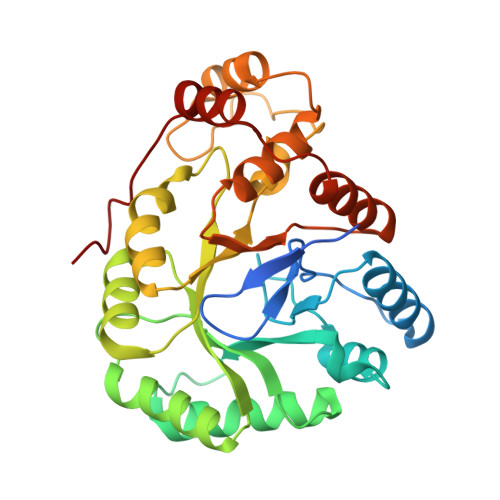High-resolution Crystal Structure of AKR11C1 from Bacillus halodurans: An NADPH-dependent 4-Hydroxy-2,3-trans-nonenal Reductase
Marquardt, T., Kostrewa, D., Balakrishnan, R., Gasperina, A., Kambach, C., Podjarny, A., Winkler, F.K., Balendiran, G.K., Li, X.D.(2005) J Mol Biology 354: 304-316
- PubMed: 16242712
- DOI: https://doi.org/10.1016/j.jmb.2005.09.067
- Primary Citation of Related Structures:
1YNP, 1YNQ - PubMed Abstract:
Aldo-keto reductase AKR11C1 from Bacillus halodurans, a new member of aldo-keto reductase (AKR) family 11, has been characterized structurally and biochemically. The structures of the apo and NADPH bound form of AKR11C1 have been solved to 1.25 A and 1.3 A resolution, respectively. AKR11C1 possesses a novel non-aromatic stacking interaction of an arginine residue with the cofactor, which may favor release of the oxidized cofactor. Our biochemical studies have revealed an NADPH-dependent activity of AKR11C1 with 4-hydroxy-2,3-trans-nonenal (HNE). HNE is a cytotoxic lipid peroxidation product, and detoxification in alkaliphilic bacteria, such as B.halodurans, plays a crucial role in survival. AKR11C1 could thus be part of the detoxification system, which ensures the well being of the microorganism. The very poor activity of AKR11C1 on standard, small substrates such as benzaldehyde or DL-glyeraldehyde is consistent with the observed, very open active site lacking a binding pocket for these substrates. In contrast, modeling of HNE with its aldehyde function suitably positioned in the active site suggests that its elongated hydrophobic tail occupies a groove defined by hydrophobic side-chains. Multiple sequence alignment of AKR11C1 with the highly homologous iolS and YqkF proteins shows a high level of conservation in this putative substrate-binding site. We suggest that AKR11C1 is the first structurally characterized member of a new class of AKRs with specificity for substrates with long aliphatic tails.
- Biomolecular Research, Paul Scherrer Institut, 5232 Villigen, Switzerland.
Organizational Affiliation:






















